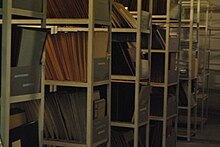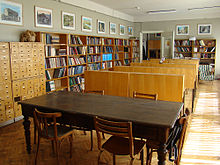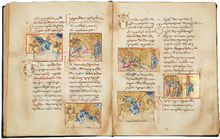Georgian National Center of Manuscripts
| Type | Scientific, research |
|---|---|
| Legal status | A legal entity under public law |
| Purpose | To support exposure of the country’s intellectual potential, to create optimal conditions for preservation, registration, restoration and conservation of the cultural heritage, to support and contribute to the promotion of the country’s cultural and intellectual heritage[1] |
| Location |
|
Director | Buba Kudava |
Main organ | Scientific council |
Parent organization | State Museum of Georgia |
| Website | manuscript |
Formerly called | Institute of Manuscripts |
The Georgian National Center of Manuscripts (Georgian: საქართველოს ხელნაწერთა ეროვნული ცენტრი; former Institute of Manuscripts) — repository of the ancient handwritten books, historical documents and private archives of the eminent public figures in Georgia. Center was established on June 30, 1958 based on the Department of Manuscript of the State Museum of Georgia. The founder and the first director of the Institute was Corresponding Member of the Georgian Academy of Sciences, Professor Ilia Abuladze. The collection of the National Center of Manuscripts comprises manuscripts, historical documents, early printed book, rare publications and heirlooms. The Center implements various projects related to the scientific research, exhibitions and restoration. Invaluable material preserved at the Center is described, systematized, studied, published, data bases are created. The Center also has rich scientific library. The memorial rooms of Korneli Kekelidze, Ivane Javakhishvili, Ilia Abuladze, Niko Berdzenishvili, Elene Metreveli, Shalva Amiranashvili function at the Center.
History
The National Center of Manuscript, under the name of "Institute of Manuscripts of Academy of Sciences of Georgia" was founded on initiative of Ilia Abuladze on the basis of the Department of Manuscripts of the State Museum of Georgia. Ilia Abuladze became the first director of the Institute. In 1962 the Institute was granted name of the Academician Korneli Kekelidze. From 1968 till 1989 Director of the Institute was Elene Metreveli, Academician of the Academy of Sciences of Georgia. During the period from 1989 to 2006 Director of the Institute was Zaza Aleksidze, Corresponding Member of the Academy of Sciences of Georgia.
In 2006 Korneli Kekelidze Institute of Manuscripts of the Academy of Sciences of Georgia was abolished and instead a legal entity under public law Korneli Kekelidze Institute of Manuscripts was established.[2] Since May 23, 2007 name of the Institute changed to "the National Center of Manuscripts". Change of the title was initiated by the staff of the Institute. This initiate was represented by the Ministry of Education and Science and was approved on the Government session.[3]
Starting from 2006 Director of the National Center of Manuscripts is Buba Kudava, Doctor of the Historical Sciences.
Structure
Organizational and administrative activities of the Center are managed by the Director, scientific and development activities is managed and resolved by the Scientific Council. In addition to that the Center contain other structural units – departments and laboratories. Currently there are eight departments (Codicology, Source Studies and Diplomatics, Archive Studies, Fund Management, Exhibition, Education, Library, Art History) and two laboratories (Restoration and Conservation, Digitalization).
Director
Director of the National Center of Manuscripts manages organizational and administrative activities of the Center. In relations with the third parties Director is an official representative of the Center and is responsible for the legitimacy, reasonability and effectiveness of the Center’s activities.[4]
According to the Charter of the National Center of Manuscripts, Scientific Council elects Director for the period of four years. Mandatory requirements for this post are high education and work experience of not less than five years.[5]
Director of the Center has a Deputy who in case of absence of the first becomes an acting Director. At present Director of the Center is Buba Kudava and his deputy is Grigol Gagnidze.[4]
Board of Scientists
The Board of Scientists of the National Center of Manuscripts together with the Director is an executive body of the Center. The Board of Scientists discusses and determines matters connected with the management and development of the Center and takes decisions by means of voting.
The members of the Board are elected for the five years period on the general meeting of the scientists of the National Center of Manuscripts. Number of the Board members depends on the number of the Center’s structural units (departments, laboratories). In the Board each structural unit is represented by one or two (if the number of the scientists in the structural unit is more than ten) scientists.
The Board is led by the Chairman elected for five years by the Board itself. At present the Chairman of the Board of Scientists is Shalva Gloveli.[6][7][8]
Structural Units
Department of Codicology
Department of Codicology performs work in two main directions:
- Edition of the original and translated of the old Georgian literature supplemented with philogical-textological and historical studies and various types of dictionaries and indexes;
- Description of the Georgian handwritten books and manuscripts in other languages preserved in repositories of Georgia and foreign countries – Jerusalem, Mount Sinai, Mount Athos, Paris, Saint-Petersburg, etc.[9]
Department of Source Studies and Diplomatics
Department of Source Studies and Diplomatics was founded at the beginning of the establishment of the Center. The specifics of the material itself defined the scientific-research activity profile of the department. The department activities mainly cover the following:
- Exact description and listing of the material, search engine optimization – preparation of different kind of catalogues.
- Expansion of the source studies’ base in Georgian history – publication of historic sources.
In the scientific-research activity of the department great attention was given to the description – research and publication oriental sources of Georgian history – Armenian, Arabic, Persian, Turkish sources.[10]
Department of Archival Studies
This Department was established in 2007 on the basis of the private archives of writers and public figures preserved at the National Center of the Manuscripts. Department works in the following directions:
- Processing of the private archives, including preparation of the descriptions and edition for publishing;
- Reprocessing of the archives;
- Creation of generic electronic catalogue with existing photo-collections;
- Scientific publications of the archival documents;
- Attraction of new archives.[11]
Department of Fund Management

The Department Fund Management manages the funds of manuscript books and historical documents as well as the private archives. Other funds created in the Department’s structure are also within its competence. The library books, the funds of memorial cabinets and articles as well as the cartography funds are managed and controlled by the Department of Library, but the issues of creation, integration or division are agreed with the Department of Fund Management.[12]
Department of Exhibition
The aim of the Department of Exhibition is to give mass appeal to the cultural heritage preserved in the Center by the means of the various exhibition projects. The Exhibition Department arranges permanent and mobile exhibitions both inside and outside Georgia. The Exhibition Department supports development of the exhibition system of the National Center of Manuscripts and it’s compliance with the international standards of exhibitions.[13]
Department of Education
Department of Education by means of the educational and exhibition projects, various programs and services implements integration of the cultural and intellectual heritage preserved at the Center in the life of society. Interaction and direct contact with this heritage Department supports self-realization and development of the members and groups of society.[14]
Department of Library

There are 10935 Georgian, 11654 Russian and 6496 other foreign books in the field of humanities kept at the main depositories of the Library of the National Center of Manuscripts. The Library also counts 3096 Georgian, 7285 Russian and about 4000 other foreign journals.
The main part of the Library books and journals are kept at depositories, encyclopedias, dictionaries and referral literature in the reading hall of the library.
The Library has an integrated catalogue that besides main depository catalogues, lists the catalogues of the books and journals kept at 6 memorial halls of the National Center of Manuscripts.[15]
Department of Art History
Department of Art History studies art of the Georgian books, works on creation and preparation of the corpus of miniatures which are included in the manuscripts for publishing. Illumination of manuscripts is studied considering chronological and thematic aspects in order to define artistic styles typical to the different scriptoriums, epoch or subject matter. Special attention is devoted to the matters related to the copyists, artists and book-binders.[16]
Laboratory of Conservation and Restoration

The Laboratory of Conservation and Restoration was established at the National Center of Manuscripts in 2006. This Laboratory replaced the former Department of the Hygiene and Restoration. In the Laboratory of Conservation and Restoration the works are performed in several directions:
- Conservation and restoration of manuscripts on parchment and paper, early printed books, historical documents, archive materials as well as the books of the Center’s Library and other materials preserved in the private collections;
- Conservation of the old and damaged pages;
- Separation of the petrified and stuck pages;
- Straightening and restoration of the deformed leaves;
- Filling the missing parts/passages;
- Binding of the loose manuscripts, restoration and conservation of the original stamped leather book-covers;
- Disinfection and cleaning of the preserved or newly acquired materials.[17]
Laboratory of Digitalization

At the Center of the National Center of the Manuscripts functions Laboratory of Digitalization, where the materials kept at the Center are scanned, sorted and encoded in digital format. Digitalization of the manuscripts, documents, miniatures and photo materials the Center supports their fixation and presentation to the scientific circles. Digitalization is also a good tool for the preservation of the existing material – in the future materials which might be lost in the course of time can be restored on the basis of the digital copy.[18]
Collection


The collection of the National Center of Manuscripts comprises handwritten books, historical documents and archival funds. The collection of the manuscripts and historical documents are divided into groups (sub-funds) according to language, in the archival fund are kept private archives of the Georgian and foreign public figures, also archives of the various organizations.
The Manuscripts
Collection of the manuscripts is divided into groups of Georgian, Oriental, Greek, Russian and manuscripts in other languages. Out of these groups collection of the Georgian manuscripts is the biggest. It comprises thousands of manuscripts, dated from 5th to 19th centuries. Among them are also palimpsests.
Collection of the Georgian manuscripts is divided into four sub-collections – A,[19] H,[20] Q[21] and S.[22] This collection contains both church and secular literary works. The preserved writings - "Martyrdom of Saint Shushanik", "Martyrdom of Evstati Mtskheteli", "Martyrdom of Abo Tbileli" form the cornerstone of the medieval Georgian church literature. Except of this collection comprises the notable works of Byzantine church literature translated into Georgian by Eqvtime Mtatsmindeli, Giorgi Mtatsmindeli, Eprem Mtsire, Arsen Ikaltoeli and other remarkable Georgian figures. From the secular literature are noteworthy handwritten copies of "Vepkhistkaosani" ("Man in the Panter Skin"), also other manuscripts containing astrological, geographic, medical, mathematic or military writings.[23]
Oriental collection mostly consists of Arabic, Persian and Turkish manuscripts. Collection preserves also around 300 Armenian, Syrian, Hebrew and one single Coptic manuscript.[24]
Collection of the Greek manuscripts contains 51 handwritten copies in Old and Modern Greek dated to the period from 9th to 18th centuries. Manuscripts are written both on paper and parchment. According to content these are mostly church writings, among them theological writings, Psalms, Chants, other, also medical writings.[25]
Collection of the Russian manuscripts comprises more than 500 manuscripts. Most of them are of the late period, from 16th to 19th century. Here are kept the Russian translations of the correspondence of the Georgian kings, nobles and of their family members, autographs of Lev Tolstoi and Pyotr Tchaikovsky, church writings, etc.[26]
Except these collections, there is also collection of the foreign manuscripts which is mixed and contains the handwritten books copied from the 15th to the 20th century in different European languages – German, Italian, Polish, French manuscripts.[27]
-
The Georgian palimpsest of the 5th-6th centuries from the collection of the Georgian manuscripts
-
Gelati Gospels, Fund of the Georgian Manuscripts
-
Persian Manuscript, Fund of the Oriental Manuscripts
-
Turkish Manuscript, Fund of the Oriental Manuscripts
Historical documents
Collection of the historical documents of the National Center of Manuscripts comprises Georgian, Armenian, Arabic, Ottoman and Persian documents. Overall number of these documents exceeds 30 000 and they are dated to 10th-19th centuries. Collection of the Georgian handwritten documents contains both secular and church documents.[28]
Arabic documents are of Dagestan origin and they represent life of the local Caucasian nations in 18th-19th centuries. One of the documents tells us about movement of Imam Shamil. Collection contains some other documents about relations of Georgia and Dagestan.[29]
Collection also includes around 200 Armenian documents, dated to 18th-19th centuries. These are various records, books of purchases and debts, official correspondence of the Armenian ecclesiastical figures. etc.[30]
The noteworthy part of the collection of the Oriental manuscripts kept at the National Center of Manuscripts are Persian and Turkish (Ottoman) documents, among them Shahs’ pirmans (orders), records, letters, purchase documents, etc. These documents illustrate political, social and economic life of Georgia and other countries in Caucasus; also represent confrontation of Russia and Persia in the Caucasus region. These documents are also important for their ornamentation – the Persian handwritten documents are decorated in accordance with the best traditions of the Persian illuminated manuscripts.[28]
Private Archival Funds
The Archival Funds of the National Center of Manuscripts are brought together archives of the Georgian and foreign scientists, writers, poets, painters, political, public and military figures, emigrant and church personalities, also archives of the Georgian Historical-Ethnographic Society and chancellery of the Synod. In whole 179 private archives are kept at the depositories of the National Center of Manuscripts, out of them 111 funds have been processed and the remaining 68 are being processed.[31]
Of the material preserved in the archival funds special mention should be made of the papyrus collection that belonged to the Georgian papyrologist Grigol Tsereteli, containing 150 papyri dating from the 2nd century B.C. – 15th century AD.
Of no less interest is the material preserved in the other archival funds: original foreign-language documents connected with the life and activities of the Georgian and foreign public figures of the 19th-20th centuries in Georgian, Latin, French, English, Italian, Russian, Azeri, Armenian and other foreign languages; the richest epistolary legacy; numerous folkloristic records; unique photographs, invaluable material reflective of the new and most recent history of the South Caucasus in the field of politics, economy, church life, journalism, theatre, music and so on.[32]
External links
References
- ^ Chapter of the National Center of the Manuscripts, 1st part of the 2nd article
- ^ History, official web-page of the National Center of the Manuscripts
- ^ New name – The National Center of the Manuscripts, official web-page of the National Center of the Manuscripts
- ^ a b The Chapter of the National Center of the Manuscripts, article 9
- ^ The Chapter of the National Center of the Manuscripts, article 10
- ^ Scientific Council, official web-page of the National Center of the Manuscripts
- ^ Rights and Responsibilities of the Scientific Council, official web-page of the National Center of the Manuscripts
- ^ The Chapter of the National Center of the Manuscripts, articles 4-6
- ^ Department of Codicology, official web-page of the National Center of the Manuscripts
- ^ Department of Diplomatics and Source Studies, National Centre of Manuscripts
- ^ Department of Archival Studies, Georgian National Centre of Manuscripts
- ^ Department of Fund Managing, Georgian National Centre of Manuscripts
- ^ Exhibition Department, official web-page of the National Center of the Manuscripts
- ^ Education Department, official web-page of the National Center of the Manuscripts
- ^ Library Department, official web-page of the National Center of the Manuscripts
- ^ Department of the History of Art, official web-page of the National Center of the Manuscripts
- ^ Restoration and Conservation Laboratory, National Centre of Manuscripts
- ^ Laboratory of Digitalization, official web-page of the National Center of the Manuscripts
- ^ A Fund of the Georgian manuscripts, official web-page of the National Center of the Manuscripts
- ^ official web-page of the National Center of the Manuscripts
- ^ official web-page of the National Center of the Manuscripts
- ^ official web-page of the National Center of the Manuscripts
- ^ The Fund of Georgian Manuscripts
- ^ The Fund of Oriental MSS
- ^ The Funds of Greek MSS (Gr)
- ^ The Fund of Russian MSS (Ros)
- ^ Mixed Fund of Various Language MSS (Varia)
- ^ a b Historical Documents
- ^ Collection of Arabic Documents (Arld)
- ^ Collection of the Armenian Documents, official web-page of the National Center of the Manuscripts
- ^ General list of the private archives preserved at the National Center of Manuscripts, official web-page of the National Center of the Manuscripts
- ^ Private Archival Funds of Public Figures




